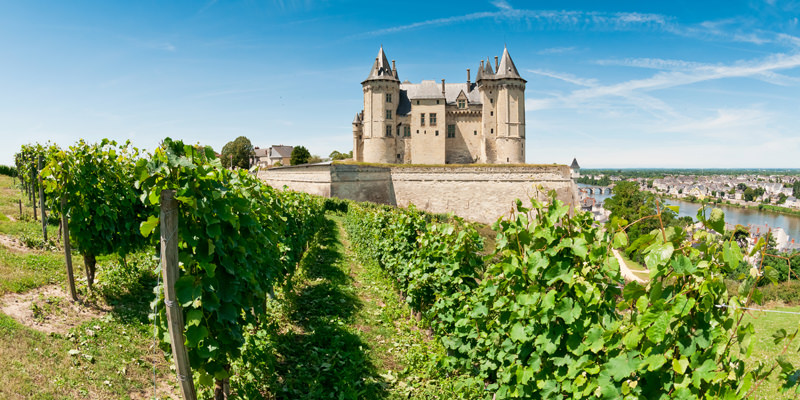When it starts to get warm and barbecue season commences, we all rejoice. Picnics, grilled meats, poolside lounging, what more could you want? And yet, despite all the richness of spring and summer, it seems that our beverage choices get narrower. Either it’s yet another bottle of rosé—which, we all know, is delicious but can get old—or a white wine, or you resort to scooping your cup into that dubious bowl of dark red sangria, just counting the minutes until the sugar gives you a headache.
Time to expand the options. For your next barbecue, try a light red wine from northwest France’s Loire Valley. Thanks to the cool climate there, which produces slightly less ripened grapes, the artisan winemakers have become experts at producing light, mineral reds with that mouth-watering acidity that makes you want to stuff a delicious bratwurst in your face. Or, if you’re feeling more civilized, charcuterie will do. Regardless, these are red wines that can brave even the hottest of days. In fact, they are best served with a slight chill—just 30 minutes in the fridge is ideal.
There are seven principal red varieties in the Loire. In order, from lightest to heaviest, you’ve got: Pinot Noir, Pineau d’Aunis, Côt, Gamay, Grolleau, Cabernet Franc, and Cabernet Sauvignon. You won’t really find Cabernet Sauvignon as a single-varietal wine in the Loire—it will typically be blended with Cabernet Franc—plus it’s not particularly light, so I chose to leave it out here.
Out of all these red grapes, I would most strongly recommend Pineau d’Aunis, Gamay, Grolleau, and young Cabernet Franc as your go-to wines on hot, sunny days. They are just so quaffable and pleasant to drink, and not too tannic. Plus, the Loire Valley is great because so many winemakers there farm organically, use indigenous yeasts, and do not add excessive amounts of the preservative sulfur, nor do they use much new oak. The result: insanely drinkable and alive, food-friendly wine, not the kind that weighs you down.
Here is a beginner’s guide to the red varieties of the Loire Valley, and some suggestions for wines to try. The wines are fairly small-production, by nature, as these are vignerons who farm and operate the winery on their own, rather than large companies. If you can’t find these exact ones, no worries, because you can just ask for the specific varieties at your local retailer. Learn the grapes, and then you’ll find the styles and producers you like.
Pinot Noir:
Although it is most well-known as the grape of Burgundy and Oregon, the northern climate of the Loire Valley gives Pinot Noir a lovely, delicate character. You’ll find it in Sancerre, where it’s simply called Sancerre Rouge, and in the nearby Menetou-Salon region. Of all the varietal red wines from the Loire Valley, these ones seem to be the most expensive, generally speaking, although I’ve definitely seen some well-priced Sancerre Rouge out there.
Try:
- Domaine Philippe Gilbert Menetou-Salon Rouge, $33
- Domaine Vacheron “Sancerre Rouge, Belle Dame,” $50
Pineau d’Aunis:
If I could reach out and pull you through the screen and seat you next to me at a wine bar, order us a bottle of chilled Pineau d’Aunis and proceed to crush it in twenty minutes, you would understand the beauty of this grape. Plus we’d both be very happy and tipsy. The signature flavor of Pineau d’Aunis (the “s” is pronounced here) is a sexy spiciness, with black pepper notes, combined with mouth-watering acidity. There is only about 400 hectares (meaning, not much) of Pineau d’Aunis left in France, so enjoy every bottle you can find!
Try:
Côt:
You’ve most likely had this grape before in its South American or Southern French guise, as Malbec. Côt is the ancestral name of that grape, and it has been grown in the Loire Valley for a long time.
Try:
Gamay:
Oh, how I could sing the praises of Gamay all day. It’s really the perfect wine for any season, but it’s spectacular in spring and summer. True, most of the Gamay wines out there are from Beaujolais, in Central France, and they are very nice. But Loire Valley Gamay can be better in hot weather because of that extra dose of acidity from being grown in the cooler climate. There’s something cheerful about Loire Valley Gamay, and definitely a bit of barnyard funk, too, in many of these wines. I highly recommended to chill these bottles.
Try:
Grolleau:
Pronounced [GROW LOW], this grape was long used for rosé production, but as you’ll see if you can get your hands on a bottle, it’s really good on its own—a bit fruity, with lots of licorice and stewed plums and cherries, and fresh acidity. It’s also quite low in alcohol (usually around 11.5%), so you can have a few glasses without getting too tanked. A no-brainer for a barbeque wine.
Try:
Cabernet Franc:
The signature perfume of Cab Franc, as this grape is affectionately called, is the herbaceous smell of a fresh-cut bell pepper—which, in scientific terms, is known as “pyrazines.” Ultimately, this is a savory wine, with a healthy dose of tannin, although the freshness from the cool climate keeps it from becoming a too-heavy red. The styles below are on the lighter side of Cab Franc. I think of Cab Franc as a food wine, so consider it for a picnic or summertime dinner party; it’s great with light meats or grilled vegetables.
Try:
Thanks to master sommelier Pascaline Lepeltier for her recent class on Loire Valley reds at Journee, which inspired this article.

